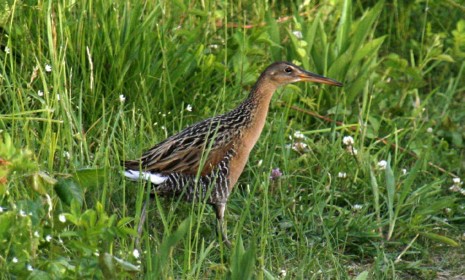Wayne R. Petersen

Photo by Wayne R. Petersen
This month’s puzzler is clearly a waterbird. Although it has the long bill and lanky legs suggestive of a heron or shorebird, the prominent, black-and-white vertical barring on its flanks is uncharacteristic of any species of Massachusetts heron or shorebird. This combination of features, and the fact that the bill is gently curved, fairly thick at the base, and clearly bicolored on the lower mandible, indicate that it is some species of rail.
Rails generally have either short, chicken-like bills, or bills that are relatively long and gently curved like that of the bird in the photograph. The only regularly observed short-billed rail in Massachusetts is the Sora, which has a yellow bill and a black throat in adult plumage, and is much smaller than the pictured bird. Although the American Coot and the Common Gallinule are both rail relatives, they also lack vertical flank barring and have significantly shorter bills than the rail in the picture. Having eliminated these three species, the remaining candidates are Virginia, Clapper, and King rail. Of these the Virginia Rail is the smallest and most common species in Massachusetts. The remaining two are nearly the same size and, depending upon the subspecies involved, can sometimes closely resemble each other in appearance. Indeed, some authorities consider the Clapper Rail and King Rail to be conspecific, meaning that they are actually one and the same species. Under the current taxonomy, however, they are treated as separate and distinct species.
The Virginia Rail, which is 9.5 inches long, is only slightly larger than a European Starling. While exact size can be difficult to judge in a picture, in comparison to the grasses and flowers around it, the mystery rail is much larger than a starling. Its relatively uniform cheek and face pattern, compared to what would be a noticeably contrasting light gray face in a Virginia Rail, and its fairly long thick bill indicate that the mystery bird is not a Virginia Rail. So the choice is between the much larger Clapper Rail and King Rail.
A careful look at the pictured rail’s flank barring shows it to be sharp and distinct, and it has a back pattern that is clearly defined, with the individual feathers distinctly showing extensive dark centers. These features alone, even if you are viewing the black-and-white photograph in Bird Observer’s print edition and cannot see the bird’s overall rusty color tones, point in the King Rail’s direction. A Clapper Rail would have less sharply defined back and flank barring and the back feathers would not be nearly as distinct, the individual feathers scarcely showing the contrasting dark centers present in the pictured rail, and a Clapper Rail would be grayer in overall color tone. Indeed, the mystery bird is a King Rail (Rallus elegans).
The King Rail is state-listed as a threatened species in Massachusetts, where it is close to the northern limit of its range in the Northeast. As a breeder in the state it is rare and local, with relatively few positively confirmed nesting records through the years. Unlike the similar Clapper Rail, which is almost exclusively confined to saltmarshes, King Rails are principally found in freshwater cattail marshes, although they occasionally occur in salt marshes during migration and rarely in winter. The author photographed this King Rail at Fort Hill in Eastham on May 30, 2010.